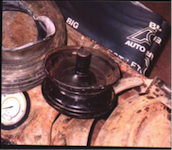Reducing Massachusetts workers’ compensation liability for employers is a great way to not only protect your business, but your employees too. So, it’s critical to know as much about workplace safety as possible—and today, the focus is tire safety.
Specifically, it is a common task at any service garage for auto technicians to service and work on tires. In many cases, however, technicians are unaware that repairing tires can be extremely hazardous, and there are even cases where this line of work has been fatal.
So, it is critical for management to develop procedures for employees to follow in order to safely do their jobs—and once developed, the procedures must be strictly enforced. If the proper procedure is not followed, these types of accidents can increase worker’s compensation claims, result in more short and long-term disability payments, and contribute to temporary and/or permanent losses in manpower.
To help your business ensure a safer work environment and avoid worker’s compensation claims, here are some safety tips that should be followed when servicing tires.
Safety Tips While Working On Tires
- Management needs to develop a safety training program and train new employees prior to doing this type of work. This training should be specific to the type of tires being serviced. It should address demounting, inspection procedures, mounting, use of restraining devices, handling of tires, installation and removal of tire assemblies, and inflation.
- Require all employees to wear appropriate eye and face protection when servicing tires. Safety glasses and safety shields should be required when doing this type of work.
- Completely deflate the tire prior to starting work.
- Use only the tools as specified by the manufacturer.
- Never hammer on the rim or the locking rim (if applicable).
- Make sure the tire is the correct size for the rim and the correct tire for the vehicle.
- Use a restraining device (like a gauge, safety t-bar or safety chains).
- Inflate tires using a clip-on device with in-line valves and gauge.
- Stand away from the direction parts may fly (and pay attention to positioning when working with a tire, in case something unexpected happens).
- Never exceed recommended tire pressures.
- Never apply heat to a tire assembly if the tire is inflated.
For more information on reducing your workers’ compensation liability for employers, visit NARFA’s Massachusetts Worker’s Compensation page, contact an NARFA representative, or read more on our Safety blog.
Recent Posts
IRS Guidance on Nutrition, Wellness, and General Health Expenses
The Internal Revenue Service (IRS) has recently highlighted that costs associated with nutrition, wellness, and general health do not typically qualify as reimbursable medical expenses [...]
HSAs Today and Every Day: A Triple Threat Against Rising Healthcare Costs
The healthcare landscape is constantly evolving, and in 2024, rising costs remain a top concern for both employers and employees. Fortunately, Health Savings Accounts (HSAs) [...]
April Showers Don’t Cause Accidents (Distracted Driving Does): Stay Safe on the Road This Month (and Every Month)
Spring is here, and with it comes April's designation as Distracted Driving Awareness Month. While the changing seasons and blooming flowers might tempt you to [...]




